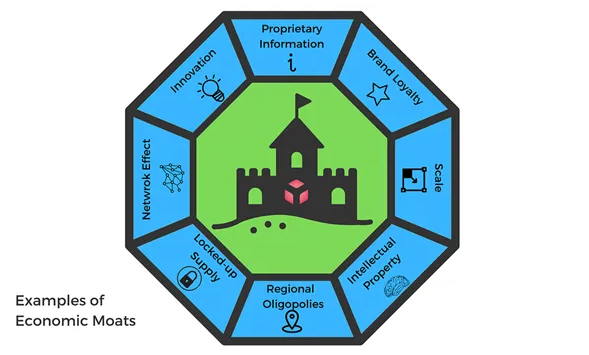I’ve been thinking about moats a lot lately. And how they apply to career and personal growth.
For those who have never heard the term, it’s common terminology among the investor folk. Warren Buffet made the phrase famous, referring to a business’s ability to maintain a competitive advantage.
You can picture it, the moat around a castle protecting it from invaders—the wider the moat, the harder to attack. Hence, a “Wide Moat” stock would have a considerable edge over other companies trying to disrupt that industry.
If you’re wondering what this has to do with your career, bear with me.
Companies need moats to protect their market share and profitability. Individuals need personal moat to protect or advance professional standing.
It’s about identifying and leveraging your unique strengths and interests to build a successful career. It’s about creating a solid personal brand that separates you from the crowd.

Personal and Professional Moats
OK, you get economic moats. Let’s talk personal and professional moats.
What is a personal moat? Well, it’s not a ditch filled with water around your desk.
No, in the context of career development, a personal moat is a unique set of strengths, skills, and interests that sets us apart from our peers.
It’s the secret sauce, our je ne sais quoi (I had to look up how to spell that), our… you get the idea.
Why is identifying and developing a moat crucial for long-term success and career satisfaction? Let’s face it. The job market is about as forgiving as a piranha with a toothache.
It’s a dog-eat-dog world out there, and if we don’t have something that sets us apart, we’re just another dog—and not even a cute one.
Our moat is what differentiates us in this competitive job market. It’s what makes employers sit up and take notice. It’s what makes us more than just a name on a resume.
It’s what makes you, well, you.
Discovering Your Moat
Discovering your moat is not like finding a sock the dryer ate. It requires introspection, self-reflection, and a good deal of honesty.
You need to identify your unique strengths, skills, and interests. And unfortunately, binge-watching The Bear Season 2 in one sitting is not a unique skill, no matter how much I wish it were.
These are things I asked myself along the way to discovering my moat, and I’m challenging you to answer them too:
- What am I good at?
- What do I enjoy doing?
- What am I passionate about?
- What values are important to me?
These are not easy questions to answer, and it may take some time to figure it out. Trust me. It’s worth it.
Now, here’s a caveat. Like many people, I fell into the trap of equating achievement with happiness.
I thought I could be happy if I just got that promotion, raise, or corner office.
But the truth is, happiness is not a destination. It’s a journey. It’s about growth, striving to be better, learning, and falling in love with the process.
It’s about being ready for the next step, whatever that may be.
So don’t just build your moat for the sake of career advancement. Build one that aligns with your values, feeds your passions, and makes you happy. Because at the end of the day, that’s what really matters.
Building and Capitalizing on Your Moat
Great, you’ve identified what sets you apart.
Now comes the hard part: building and capitalizing on it.
Building your moat is more than just a one-and-done deal. It’s not like building a sandcastle, where you can pat yourself on the back, snap a few photos, and then watch as the tide washes it away.
Building your moat is a continuous process. It requires dedication, perseverance, and a willingness to step outside your comfort zone.
How do you do it? Well, it’s not rocket science unless, of course, your moat is rocket science. In that case, it’s precisely rocket science.
But for the rest of us, it’s about leveraging our strengths and interests to increase opportunities.
Let’s say, for example, you have a knack for public speaking. Consider joining a local Toastmasters club, taking a improv comedy training, or volunteering to present at company meetings. Over time, you could become the go-to person for presentations and speeches, making you a valuable asset to the company.
If your moat is your ability to connect with people, you could capitalize on this by networking, mentoring, or taking on leadership roles. You could become the person everyone turns to for advice, support, or a friendly chat.
For me, I was doing pentests when Metasploit came out, and I saw the writing on the wall of that skill becoming commoditized.
I decided to niche down to AppSec.

Then I, by force, moved into cloud security. This was an excellent niche, but I went one level deeper and focused on Kubernetes in 2015 when it was still in Beta.
I was one of the only people knee-deep in k8s security, and I shipped a “Kubernetes Security” talk around a few DevOpsDays and other conferences.
This landed me my following few jobs as everyone started firing up containerization and Kubernetes initiatives, and there was only a handful of security folk with hands-on experience there.
I was one of them.
But remember, building a moat is not a sprint. It’s a marathon. It’s about continuously improving and expanding your skills over time.
It’s about staying curious, hungry and never resting on your laurels.
Here’s a tip: don’t be afraid to fail.
Failure is not the opposite of success. It’s part of success. It’s how we learn, how we grow, and how we become better. So don’t be afraid to take risks, try new things, to step outside your comfort zone because that’s where the magic happens.
So go forth, build your moat, and conquer the world. Or at least, your little corner of it.
Because remember, in the grand scheme of things, none of this matters, and we’re all just playing with computers. Wait, too nihilistic…
Nurturing Your Moat in a Changing Landscape
You might be thinking, “I’ve identified my moat, I’ve built it, I’ve capitalized on it. I’m done, right?”
Oh, if only it were that simple. The world is not a static place. It’s constantly changing, evolving, and throwing curveballs our way.
And just like a castle’s moat needs to be maintained and updated to withstand new forms of attack, your moat needs to be nurtured and adapted to stay relevant in a rapidly changing job market.
The job market is a fickle beast, and what’s in demand today might be obsolete tomorrow. So, it would be best if you were adaptable. It would help if you were willing to learn, grow, and evolve.
My moat was AppSec related for a while before that didn’t set me apart from the crowd anymore. I’m likely towards the tail end of my standing out as a k8s security person, as there are entire conferences dedicated to that now.
Guess I’m entering my chameleon era, changing and adapting to the environment, except, you know, without the weird eyes and the long tongue.
Adaptation is more manageable than it sounds. It’s about staying curious, staying informed, and staying proactive. It’s about seeking growth opportunities, whether that’s through further education, professional development, or simply learning from your experiences. It’s about staying updated on industry trends, so you can anticipate changes and adapt accordingly.
Think of the twitter users with large followings. They’ve built up this community, perhaps made a living from it and now have to figure out how to navigate with the introduction of the new competing platform, Threads.
Do they have to start from scratch? Do they stick to tried-and-true methods, or learn the ins and outs of the new platform and incorporate it into their strategy?
Ultimately, what sets you apart is not your skills, not your experiences, but your ability to adapt, grow, and overcome challenges.
So, what are we waiting for? The world is our oyster, and it’s time to find a pearl.
Remember, your moat is not just about what you do but who you are.
It’s not just about your skills but your passions.
It’s not just about your experiences but your values.
So embrace your moat, nurture it, and let it shine. Because you’re not just another face in the crowd.
You’re a force to be reckoned with.





